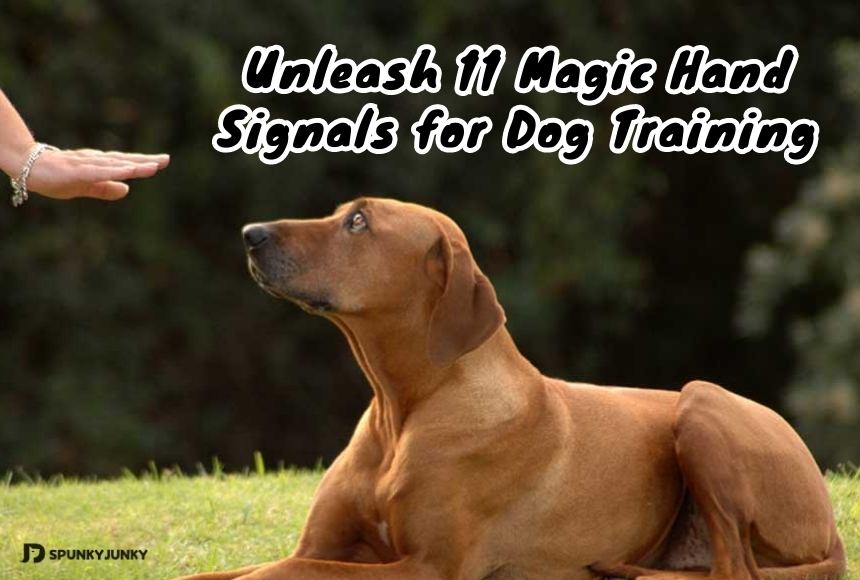Hi! Dog owners, let's enter the world of dog gestures together!
Not only are hand signals for dog training practical, but it's also the secret to unlocking a whole new dog charm! Plus, your furry friend will be ecstatic and your bond will be stronger than ever.
Guess what? It's easier than training dogs to fetch food -- they're naturally good at reading our body language. So get ready for some hilarious "high five" and "sit nice" moments that will make both of you laugh.
Don't wait any longer, let's get started!
Why Use Hand Signals for Dog training?
Teaching your dog hand signals has so many perks! Just like us, dogs rely on their hearing and seeing senses. Hand signals create a stronger connection with your furry friend and ensure better understanding, especially in noisy or challenging situations.
Hand signals are helpful if your dog has hearing issues or is easily distracted by noise. They'll stay focused on you, making training a breeze. Plus, it keeps their clever minds busy, preventing boredom and bringing you closer.
If your pup becomes deaf later in life, hand signals are a lifeline for communication. You can rely on them to stay in sync, even off-leash! And if you're into fancy obedience competitions, hand signals are a must. Dogs are champs at reading body language and respond incredibly accurately.
So, go ahead and give hand signals a try during training. Your dog will love it, and you'll see its paw-positive impact on your training journey!
11 Common Hand Signals for Dog Training

Now that you know the benefits of hand gesture training for dogs, let's explore the hand gestures commonly used in dog training. These signals can serve as effective cues to help your furry friend understand what you want them to do.
1. Attention Command: Encourage your dog to look at you by pointing a finger from the side of your face toward your eyes. Once your dog makes eye contact, mark the behavior with praise and rewards.
2. Sit: Show your dog what you want with your hand, palm up, in front of their nose, then slowly move your hand up toward their forehead. This signal helps entice them to sit up.
3. Downwards: Put the index finger horizontally on the chest, and use the clenched fist to hold the treat to guide the dog down. You can even wag your finger toward the floor to help them understand commands.
4. Stay: To keep your dog safe, teach them the stay command. Raise your hands, palms facing away from you, at waist height or slightly higher. Keep the signal low for smaller dogs and above the waist for taller dogs.
5. Come: Teach your dog to come closer to you, making a sweeping motion next to your body (palms out) as your signal, and finally, place your palm lightly on your chest. This order is critical to their safety.
6. Heel: To get your dog to walk obediently, teach your dog to walk with the shoulder close to your left leg. You can use circular motions or pats on the hip to keep your dog in that position.
7. Throw it away: Train your dog to throw items away to keep them safe from harmful objects or while playing. Show them your clenched fist and reward them with praise and treats when they drop toys.
8. Place commands: Teach your dog to go to a designated spot, such as a bed or crate, by pointing his finger at a spot. When your dog understands what to expect, gradually move away from the object and reward them when they follow the cue.
9. Well done! : Let your dog know they are doing a good job by giving them a thumbs up. Praise and treat them immediately to reinforce positive behavior.
10. Quiet: Teach your dog quiet cues to help them stay calm. Hold your index finger perpendicular to your lips to signal them to stop barking.
11. Rest time: After training, give your dog a break. Show them at the end of the exercise with arms raised, palms facing forward, and hands moving a few times simultaneously. Let them enjoy some playtime or relax after a hard day's work.
By incorporating these gestures into your training routine, you'll establish clear communication with your canine companion, making training a rewarding and enjoyable experience for both of you.
How to Teach Your Dog Hand Signals

Alright, fellow dog trainers, it's time to unleash the power of hand signals and have some awesome fun with our furry pals! Follow these steps and tips to teach your dog those fancy moves:
1. Distraction-Free Zone: Find a chill spot where your dog can give you undivided attention. No squirrel distractions allowed!
2. One Trick at a Time: Let's not overwhelm our doggo geniuses! Focus on teaching one cool trick with a hand signal at a time.
3. Eye Contact Alert: Get those puppy eyes locked on you! Make sure your pup is giving you the adorable stare before we proceed.
4. Verbally Cool, Hand Signal Cooler: Introduce the hand signal while saying the cue a few times. Keep it smooth like a dog sliding on a freshly waxed floor!
5. The Big Test: Drop the voice cue and go all silent movie style – use only the hand signal. Don't worry if it's like speaking doggy sign language at first. We'll get there!
6. Mix It Up: Keep things interesting! Try the hand signal and verbal cue separately in random order.
7. Distraction Graduation: Once your pup's a hand signal pro, crank up the challenge! Practice in the park, during rush hour, or even at a doggy rock concert!
Patience and fun are the keys to doggy hand signal training success. So grab those treats, gear up with your coolest hand moves, and let the training party begin!
Final Thoughts
And there you have it, my fellow dog enthusiasts!
Embrace the power of hand signals and embark on a journey of wag-tastic communication with your furry besties. Not only will you witness some hilarious high-fives and adorable sits, but your bond with your fur baby will reach more high levels!
Remember, using hand signals in training offers a world of benefits. It's like speaking doggy body language, and they love it! So, get creative, stay patient, and enjoy every moment of this paws-itively thrilling training adventure.






